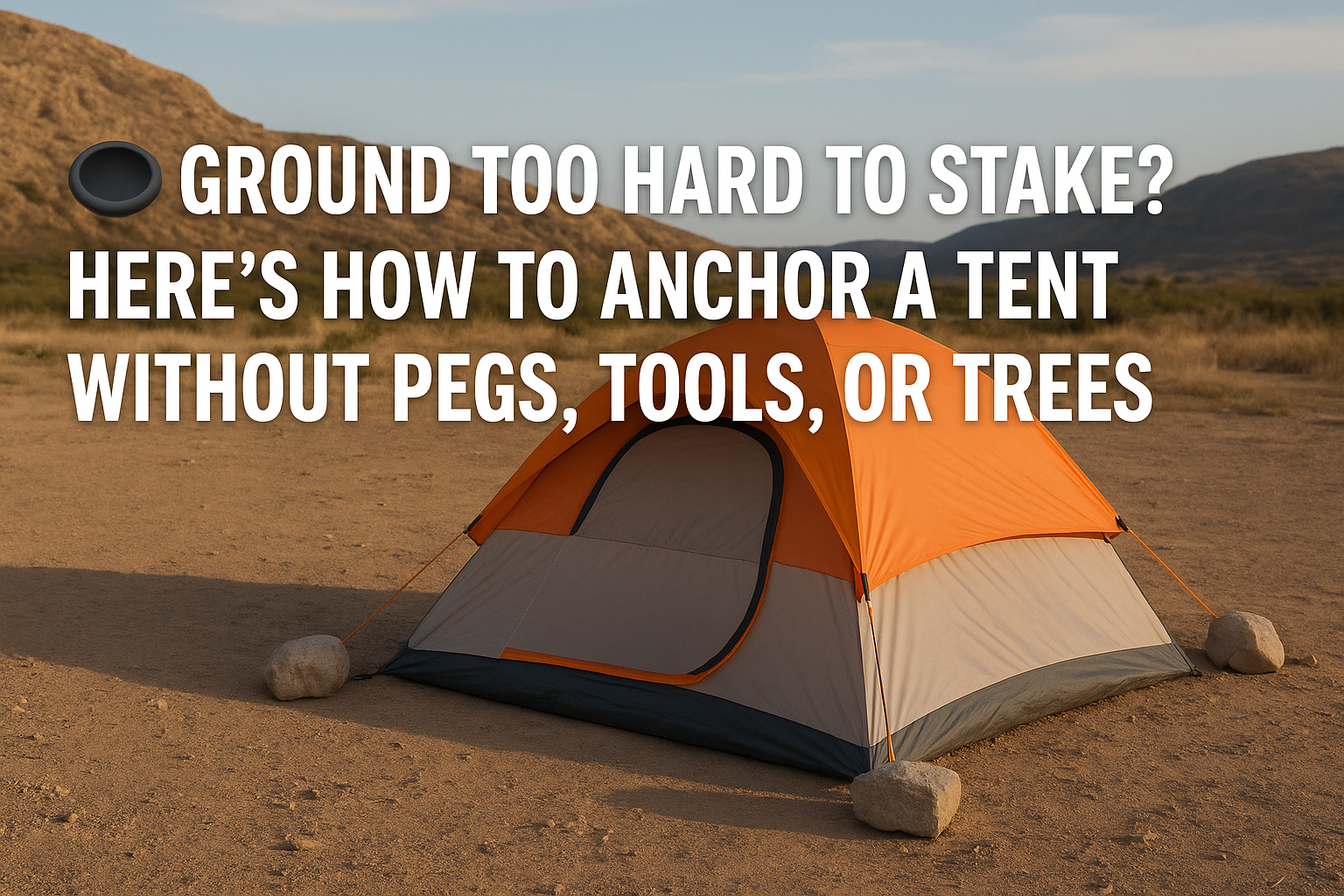You’re pitching camp on shale, desert crust, frozen earth, or compacted gravel — and every stake bends or bounces back out. There are no trees, no soft spots, and your mallet might as well be a spoon. If you’re still relying on “use a heavy rock,” you’re one wind gust away from disaster.
This guide skips the garbage and gives you real anchoring systems that work with zero pegs, zero tools, and zero tie-off trees — even when the ground’s hard as concrete.
⚠️ First: What You’re Up Against
Ground too hard to stake usually means one of three things:
- Inflexible crust – desert, dry tundra, high alpine
- Rock slab or gravel – nowhere to grip, nothing to pound
- Frozen terrain – permafrost or icy soil
In all three, traditional stakes fail because there’s no penetration, no friction, and no bite.
So we don’t fight the ground.
We anchor by distribution, suspension, and redirection.
🧠 Field-Tested Ways to Anchor Without Stakes, Tools, or Trees
1. Ziploc Sand Sled Anchors (Portable Surface Drag)
Problem: You’re in a desert flat or rock slab with no diggable surface.
Fix:
- Fill 2–4 quart-sized Ziploc freezer bags with sand, dust, or gravel.
- Wrap each bag in a t-shirt, sock, or tent bag and twist it tight.
- Tie your guy line to the twisted fabric section, not the bag itself.
- Drag the bag outward and let it lie flat on the surface.
Now your tent is being held by surface tension, not penetration.
Why it works: The soft material grabs friction and prevents slip. The weight doesn’t matter — it’s the grip across surface drag that resists wind.
✅ Especially effective on dry lakebeds, canyon ledges, and high deserts.
2. The Triangle Tension Lock
Problem: You need vertical anchor strength, but the ground is rock.
Fix:
- Form a triangle using your own tent cord, with three equal sides.
- Attach the guy line to the center of the triangle.
- Lay the triangle flat and pile gear, stuff sacks, or your pack evenly on each corner.
Why it works: This structure distributes lateral tension through 3 points, locking the central line in place even under dynamic movement (wind, shifting weight).
It’s like building a tent-hitch tripod out of nothing — no stakes, no weightlifting.
3. Deadman Anchoring With Your Own Tent Bag (But Not Buried)
Everyone else buries a deadman (log, rock, stick) in sand or snow. But you don’t have diggable ground.
Fix:
- Roll your tent bag into a tight coil.
- Tie your guyline around the center like a sushi roll.
- Place it on the ground, and lay your pad, bag, or food sack on top, offset 45° from the pull angle.
Why it works:
The bag forms a tension-dispersing anchor. The object on top presses against the force vector, like a movable wall, stopping sideways drag.
It’s an improvised counter-torque anchor using gear you’re already packing.
4. Inverted Pole Tension System
Problem: You can’t get corner anchors, and the wind is shifting the structure.
Fix:
- Flip your trekking pole, tent pole, or hiking stick upside down.
- Run two guy lines from opposite tent corners to the midpoint of the inverted pole.
- Angle them outward to create an A-frame tension zone.
Why it works:
You’re bracing the tent’s pull forces against each other, not the ground. The pole becomes a dynamic tension post, reducing tent movement without needing hard anchors at all.
✅ Especially effective in windswept ridge camps where stakes always fail.
5. Soft Gear Interlock Anchoring (No Tie Points Required)
Problem: Your guy lines keep slipping or pulling free from makeshift weights.
Fix:
- Fill a dry sack or compression sack halfway with gear.
- Tie your guyline around the middle, cinch it tight.
- Then pack soft, pliable gear around the line inside — like socks, underwear, base layers.
- Close the bag and lay it flat.
Why it works:
The line is now embedded in soft, shifting mass — it can’t pull free without displacing the entire sack. It’s like casting your line in cement that conforms to it.
✅ Bonus: You can use multiple bags in a daisy chain to stabilize several corners.
⚡ What to Do When You Can’t Stake Corners or Guy Lines
Sometimes the ground is bad, the wind is brutal, and you don’t even have guy lines set up. You can still pitch.
6. Internal Weight Lock System (Tent Becomes Its Own Anchor)
Fix: Use your backpack, water bottles, or food bag as interior ballast — one per corner or edge.
Place them directly over the floor fabric where each guy line would pull.
Shape the tent so each side is pressed into the ground by weight, not tension.
Why it works:
You’re shifting from external resistance (stakes) to internal counterweight.
It’s not pretty — but it will survive 25–30mph gusts if distributed evenly.
7. The Tension Braid Trick (No Knots, No Movement)
Fix: Tie a short loop into your guy line. Then braid it through itself three times to a bag handle or gear loop.
Pull tight — and let go.
Why it works:
Braid tension creates directional friction that locks harder the more it pulls — without needing knots, hooks, or pegs.
When the line tugs in the wind, the braid cinches tighter.
Use this trick when anchoring to bags, boots, or non-loop objects.
🧠 Bonus Tactical Principle: Use Opposition Anchoring
If all else fails and you’re truly stuck:
- Use opposing guy lines to pull against each other, not the ground.
- Run one line from each side of the tent through a shared loop and pull tight.
- Secure the center loop with one heavy object (like your water bladder).
This is called opposition anchoring — it works on boats, ultralight tents, and snow shelters.
It doesn’t resist pull — it neutralizes it by equalizing tension across internal force vectors.
🧭 Final Thoughts: You Don’t Need Stakes. You Need Strategy.
Most people lose their shelter not because they forgot gear — but because they didn’t know how to anchor with intelligence when the ground said no.
Now you know how to:
- Build drag-based friction systems without trees
- Redirect tension into braided locks
- Use your gear as anchors, buffers, and tension dispersers
- Think in force vectors, not just weights
And you’ll never watch your tent become a tumbleweed again.

